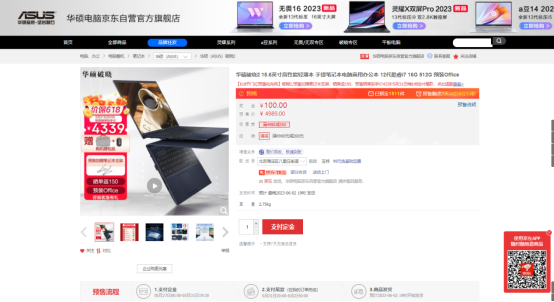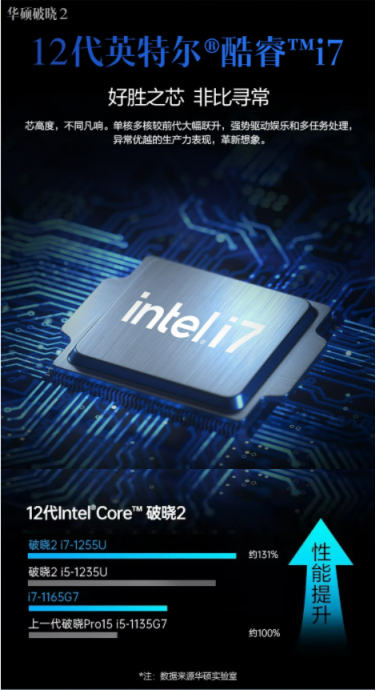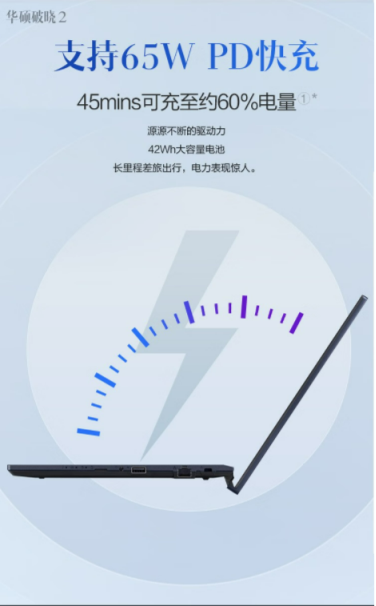 Technology peripherals
Technology peripherals
 It Industry
It Industry
 The perfect combination of performance and thinness, ASUS Daybreak 2 allows you to achieve whatever you want in the workplace
The perfect combination of performance and thinness, ASUS Daybreak 2 allows you to achieve whatever you want in the workplace
The perfect combination of performance and thinness, ASUS Daybreak 2 allows you to achieve whatever you want in the workplace
Workers are eager to improve work efficiency and travel convenience, so they need computers that are thin, light and powerful. A notebook with powerful performance and fast response will improve the office efficiency of workplace users; while a thin, light and portable notebook will reduce the fatigue of travel for users on business trips and obtain a more comfortable work experience. In response to these two needs, ASUS Daybreak 2 thin and light business notebook provides users with a perfect solution.
ASUS Daybreak 2 thin and light business notebook, equipped with 12th generation Intel® The Core™ i7-1255U processor is only 1.94cm thick and weighs only 1.73kg. It has abundant performance and excellent computing power, coupled with a thin and light body, it is a wise choice for workplace users who pursue efficient and relaxed work. choice.
Product link: https://item.jd.com/10066984623967.html

##The inner "core" is surging to help you in the workplace" Core" as you wish
When users choose any laptop product, they will first consider whether its performance is strong. For users who pursue efficient office work, office notebooks are their first productivity. Notebooks The performance configuration is naturally the focus of their greatest attention. ASUS Daybreak 2 thin and light business laptop, equipped with 12th generation Intel® The Core™ i7-1255U processor adopts a ten-core, twelve-thread design, a L3 cache of 12MB, and a maximum turbo frequency of 4.7GHz. It has excellent computing power and can smoothly run various current office software, allowing users to successfully complete document editing. Data statistics, PPT writing and other work can be done efficiently in a relaxed and comfortable environment.
The body is light and thin, no pressure, no burden when traveling
As an office notebook that can reduce the burden on users, if only It is obviously not enough to achieve excellent performance. Thinness, lightness and portability are also an essential prerequisite for it. If the laptop carried by the workplace is too heavy during business trips, it will put additional burden on the already tired users. ASUS Daybreak 2 is a thin and light office business notebook with a body thickness of only Measuring 19.4mm and weighing only 1.73Kg, users can easily put it into their computer bags and carry it with them. It is also stress-free to carry it on the plane during business trips, making it the best companion for easy travel on the road.
Ultra-large battery allows you to say goodbye to battery life worries
For users who are on business trips, the battery life of notebooks is also exceptional Importantly, if users encounter the problem of insufficient laptop power during work, it will inevitably seriously affect their office progress. ASUS Daybreak 2 thin and light business laptop is equipped with a 42Wh large-capacity battery that can be charged to 60% power in 45 minutes, allowing users to worry about insufficient power affecting their efficiency and allowing them to work without worries. In addition, ASUS Daybreak 2 thin and light business notebook is also equipped with a fingerprint unlocking function for users. Compared with traditional keyboard and password unlocking, fingerprint unlocking is more convenient and can better protect user privacy.
The above is the detailed content of The perfect combination of performance and thinness, ASUS Daybreak 2 allows you to achieve whatever you want in the workplace. For more information, please follow other related articles on the PHP Chinese website!

Hot AI Tools

Undresser.AI Undress
AI-powered app for creating realistic nude photos

AI Clothes Remover
Online AI tool for removing clothes from photos.

Undress AI Tool
Undress images for free

Clothoff.io
AI clothes remover

Video Face Swap
Swap faces in any video effortlessly with our completely free AI face swap tool!

Hot Article

Hot Tools

Notepad++7.3.1
Easy-to-use and free code editor

SublimeText3 Chinese version
Chinese version, very easy to use

Zend Studio 13.0.1
Powerful PHP integrated development environment

Dreamweaver CS6
Visual web development tools

SublimeText3 Mac version
God-level code editing software (SublimeText3)

Hot Topics
 1664
1664
 14
14
 1423
1423
 52
52
 1321
1321
 25
25
 1269
1269
 29
29
 1249
1249
 24
24
 Performance optimization and horizontal expansion technology of Go framework?
Jun 03, 2024 pm 07:27 PM
Performance optimization and horizontal expansion technology of Go framework?
Jun 03, 2024 pm 07:27 PM
In order to improve the performance of Go applications, we can take the following optimization measures: Caching: Use caching to reduce the number of accesses to the underlying storage and improve performance. Concurrency: Use goroutines and channels to execute lengthy tasks in parallel. Memory Management: Manually manage memory (using the unsafe package) to further optimize performance. To scale out an application we can implement the following techniques: Horizontal Scaling (Horizontal Scaling): Deploying application instances on multiple servers or nodes. Load balancing: Use a load balancer to distribute requests to multiple application instances. Data sharding: Distribute large data sets across multiple databases or storage nodes to improve query performance and scalability.
 C++ Performance Optimization Guide: Discover the secrets to making your code more efficient
Jun 01, 2024 pm 05:13 PM
C++ Performance Optimization Guide: Discover the secrets to making your code more efficient
Jun 01, 2024 pm 05:13 PM
C++ performance optimization involves a variety of techniques, including: 1. Avoiding dynamic allocation; 2. Using compiler optimization flags; 3. Selecting optimized data structures; 4. Application caching; 5. Parallel programming. The optimization practical case shows how to apply these techniques when finding the longest ascending subsequence in an integer array, improving the algorithm efficiency from O(n^2) to O(nlogn).
 Nginx Performance Tuning: Optimizing for Speed and Low Latency
Apr 05, 2025 am 12:08 AM
Nginx Performance Tuning: Optimizing for Speed and Low Latency
Apr 05, 2025 am 12:08 AM
Nginx performance tuning can be achieved by adjusting the number of worker processes, connection pool size, enabling Gzip compression and HTTP/2 protocols, and using cache and load balancing. 1. Adjust the number of worker processes and connection pool size: worker_processesauto; events{worker_connections1024;}. 2. Enable Gzip compression and HTTP/2 protocol: http{gzipon;server{listen443sslhttp2;}}. 3. Use cache optimization: http{proxy_cache_path/path/to/cachelevels=1:2k
 The Way to Optimization: Exploring the Performance Improvement Journey of Java Framework
Jun 01, 2024 pm 07:07 PM
The Way to Optimization: Exploring the Performance Improvement Journey of Java Framework
Jun 01, 2024 pm 07:07 PM
The performance of Java frameworks can be improved by implementing caching mechanisms, parallel processing, database optimization, and reducing memory consumption. Caching mechanism: Reduce the number of database or API requests and improve performance. Parallel processing: Utilize multi-core CPUs to execute tasks simultaneously to improve throughput. Database optimization: optimize queries, use indexes, configure connection pools, and improve database performance. Reduce memory consumption: Use lightweight frameworks, avoid leaks, and use analysis tools to reduce memory consumption.
 How to quickly diagnose PHP performance issues
Jun 03, 2024 am 10:56 AM
How to quickly diagnose PHP performance issues
Jun 03, 2024 am 10:56 AM
Effective techniques for quickly diagnosing PHP performance issues include using Xdebug to obtain performance data and then analyzing the Cachegrind output. Use Blackfire to view request traces and generate performance reports. Examine database queries to identify inefficient queries. Analyze memory usage, view memory allocations and peak usage.
 The impact of exception handling on Java framework performance optimization
Jun 03, 2024 pm 06:34 PM
The impact of exception handling on Java framework performance optimization
Jun 03, 2024 pm 06:34 PM
Exception handling affects Java framework performance because when an exception occurs, execution is paused and the exception logic is processed. Tips for optimizing exception handling include: caching exception messages using specific exception types using suppressed exceptions to avoid excessive exception handling
 Optimizing rocket engine performance using C++
Jun 01, 2024 pm 04:14 PM
Optimizing rocket engine performance using C++
Jun 01, 2024 pm 04:14 PM
By building mathematical models, conducting simulations and optimizing parameters, C++ can significantly improve rocket engine performance: Build a mathematical model of a rocket engine and describe its behavior. Simulate engine performance and calculate key parameters such as thrust and specific impulse. Identify key parameters and search for optimal values using optimization algorithms such as genetic algorithms. Engine performance is recalculated based on optimized parameters to improve its overall efficiency.
 How to use profiling in Java to optimize performance?
Jun 01, 2024 pm 02:08 PM
How to use profiling in Java to optimize performance?
Jun 01, 2024 pm 02:08 PM
Profiling in Java is used to determine the time and resource consumption in application execution. Implement profiling using JavaVisualVM: Connect to the JVM to enable profiling, set the sampling interval, run the application, stop profiling, and the analysis results display a tree view of the execution time. Methods to optimize performance include: identifying hotspot reduction methods and calling optimization algorithms



